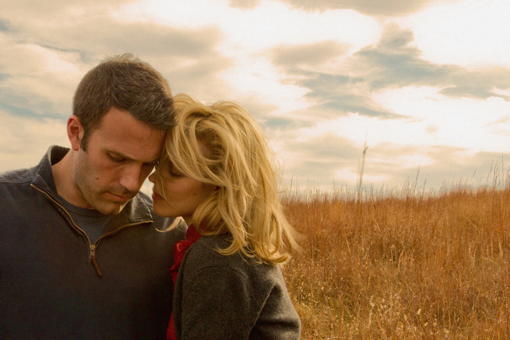By Meredith Alloway · April 10, 2013

Theater curtains open to reveal a girl dressed in black. Tchaikovsky plays. She dances gracefully. She is free, happy and inspired. Then it sounds as if the record has a scratch. The music slows and her movements coincide. Eventually, she crawls like a snail on the stage. The music has become warped and her limbs stick to the stage like glue. But as the record stops, and she nearly falls asleep on the orchestra pit, we hear her hum. She begins to sing to herself and with this music, her body rises. She finishes her performance to her own tune.
If I had time to video myself doing this, I would’ve. It seems the only appropriate reply to Terrence Malick’s latest…venture. To the Wonder is not a film; it’s an entity of a director’s imagination. Reviewing it with words seems inappropriate. But alas…
The film seemed to sprout out of nowhere. There hasn’t been much publicity on the US release with Magnolia Pictures after its premiere at Venice and Toronto festivals. But perhaps it’s a good thing you go into Malick with a clean mind. This one will land on everyone differently. Just because Ben Affleck stars doesn’t mean you’ll be getting any dose of Hollywood.
It’s about an American man who loves a French woman with a daughter. They live together, and then they part. He meets another woman but loses interest fast when the French woman comes back around. They’re never happy. That’s the story. No, I didn’t leave much out. Ben Affleck plays this man, Neil, who we infer has a job in building housing developments. When Marina (Olga Kurylenko) and her daughter Tatiana (Tatiana Chiline) move in with him, they quickly feel unsatisfied. They’re birds with clipped wings. Soon looking out windows longingly tires Marina, and she decides it’s best to move back home.
Neil runs into a woman from his hometown, Jane (Rachel McAdams), and they begin a romance. But before Jane can wrangle a ring, Marina returns. She and Neil marry in order to obtain her Visa. Their union solves very little, and we witness their marriage unravel. But it’s never sad; it just feels true. Oh! Then there’s Javier Bardem as the priest in their town. Apparently, his story got slightly cut down.
The landscape Malick chooses is perhaps the most intriguing character in the film. I should stop using that word… the “piece.” The piece finds its canvas among half-completed, still under construction housing communities. They’re model homes with perfectly squared backyards. If Malick’s last work was called Tree of Life, this could be called Lack of Trees. It’s one of the eerie elements of these plots of land; trees are scarce and plants are only starting to bud.
But Malick, like his characters, is starving to find beauty in the starkness. Perhaps the greatest moment of joy for Marina is planting a small garden. She’s living the American Dream. She has a handsome husband with a job adequate enough to not require her employment. She has her days to wander fields and play in the sun. But for a French ballerina, it’s a waltzing nightmare. Although at first her physicality and behavior seems childlike, it’s soon apparent it’s the result of entrapment and boredom. There’s a reason children need recess – to escape from the confinement of the classroom.
The core of To the Wonder is strong. It pulses even when the film grows weary. The monotony the characters are plagued with soon befalls the audience. There are only so many windows to gaze out of and scarves to twirl. But this core keeps the film from drowning in cinematic pretension. Malick doesn’t claim to hold the key or know the answers. He’s asking the questions. His camera is observing a simple story, a story so simple that it’s familiar to us all: Love. It may sound cliché, but the piece is anything but. Malick is communicating in an entirely new language.
With multiple characters cut from the final version, hours of footage and the lack of a coherent script, it’s clear this isn’t a film. It’s deceiving at the length of a film, shown in theaters like a film and with film stars. But it’s a ballet. It’s a painting. To some it may be a scientific experiment. Because Malick is pioneering this new path of cinematic experience, To the Wonder sometimes suffers. It drags and at times is so vague that the energy required to understand it isn’t worth the headache. But no one goes to the ballet to understand. They go to feel and to listen and maybe once they can do both, the understanding will come.